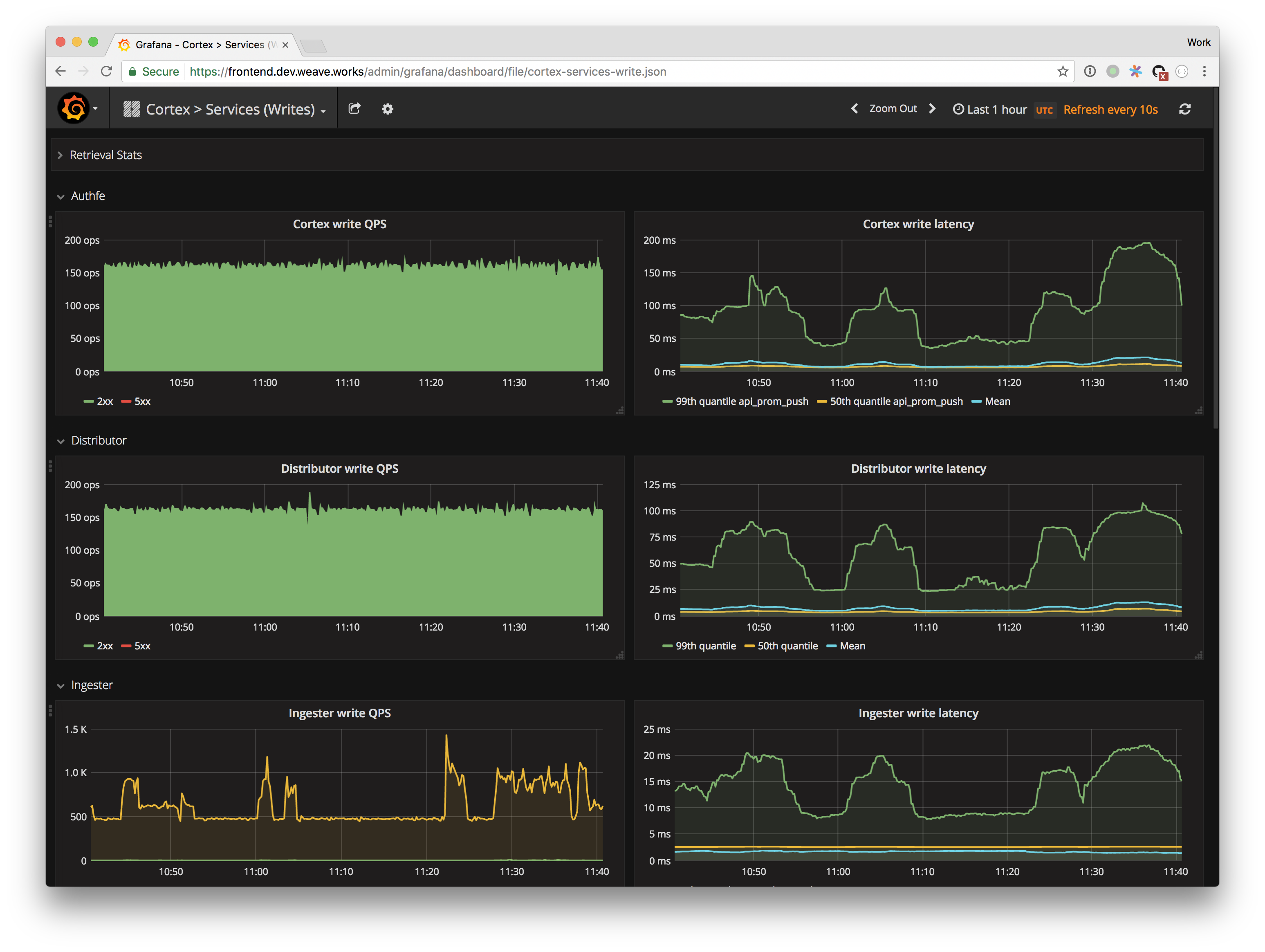Prometheus 101
anarcher@gmail.com
2019-09-25

Selling Points
- Dimensional data model
- Powerful query languages
- Simplicity + efficiency
- Service discovery integration
Data Model
What is a time series?
<identifier> -> [ (t0,v0), (t1,v1),... ] ^ ^ ^ | | |What is this? int64 float64Data Model
Graphite/ StatsD:
nginx.ip-1-2-3-4-80.home.200.http_requests_totalnginx.ip-1-2-3-5-80.settings.500.http_requests_totalnginx.ip-1-2-3-5-80.settings.400.http_requests_totalnginx.ip-1-2-3-5-80.home.200.http_requests_totalPrometheus:
http_requests_total{job="nginx",instance="1.2.3.4:80",path="/home",status="200"}http_requests_total{job="nginx",instance="1.2.3.5:80",path="/settings",status="500"}http_requests_total{job="nginx",instance="1.2.3.5:80",path="/settings",status="400"}http_requests_total{job="nginx",instance="1.2.3.4:80",path="/home",status="200"}Data Model
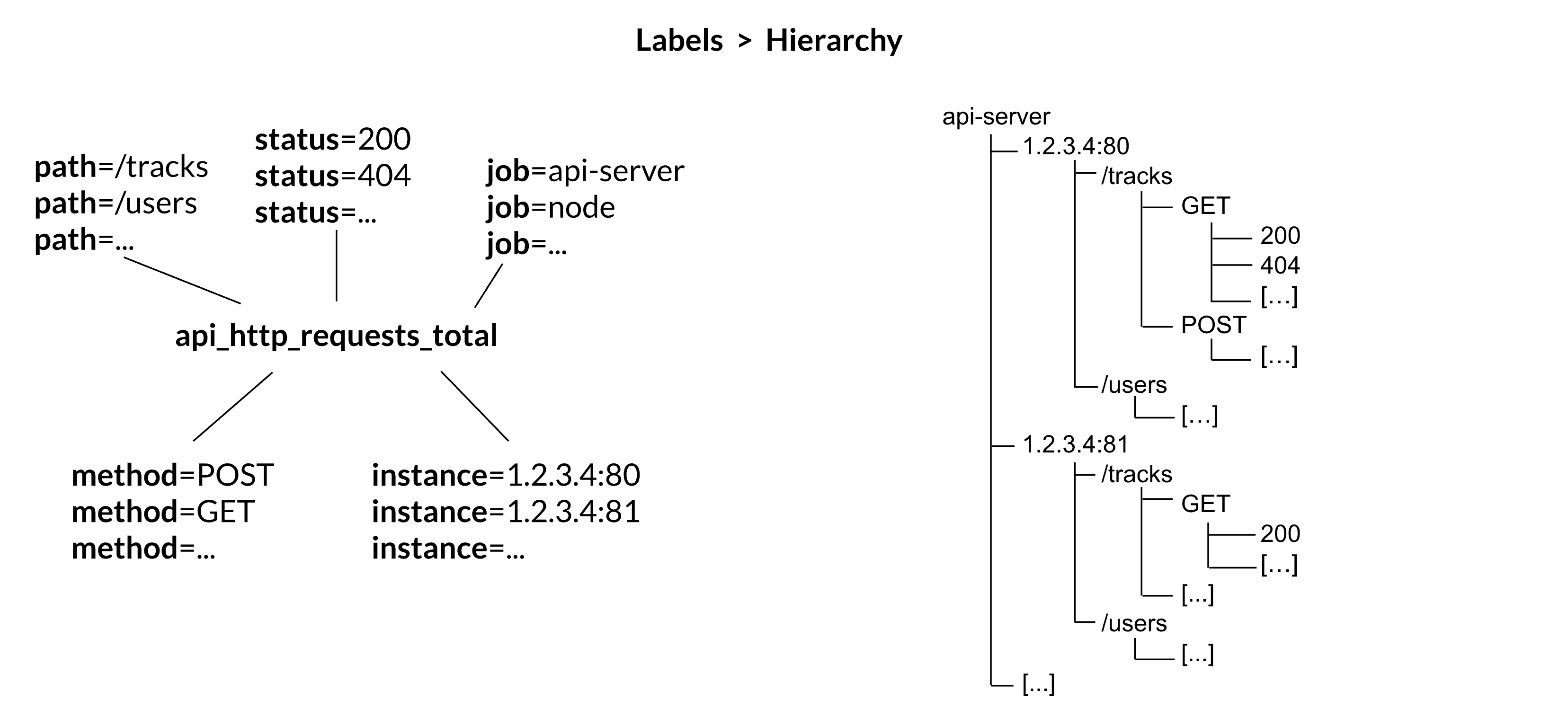
Selecting Series
nginx.*.*.*.500.*.http_requests_total- Implies hierarchy that doesn't exist
- User-level encoding of semantics
- Hard to extend
http_requests_total{job="nginx",status="500"}- more flexible
- more effcient
Prometheus vs InfuxDB
https://timber.io/blog/prometheus-the-good-the-bad-and-the-ugly/
InfluxDB and Prometheus ended up being the major competitors. They both offered stand-alone binaries, did not require the management of external data systems, and allowed for rich metadata on metrics. The two key differences between the offerings were:
- Prometheus will pull data from services, while InfluxDB needs data to be pushed to the InfluxDB instance
- InfluxDB collects every data point while Prometheus only collects summaries of data points
Both of these points have their benefits and trade-offs. By collecting every data point, InfluxDB can support complex, high-resolution queries at the cost of higher network traffic and larger on-disk storage. And pushing data to InfluxDB means that the origin system can be located anywhere; whereas Prometheus ingests data by scraping metric summaries (in plain text format) from HTTP endpoints on every server.
Prometheus vs Graphite
Graphite Archives: Retention and Precision
Whisper databases contain one or more archives, each with a specific data resolution and retention (defined in number of points or max timestamp age).
# storage-schemas.conf[carbon]pattern = ^carbon\.retentions = 1m:14d,15m:30d[instances]pattern = ^ganglia\..+\.(huge-instances).+\..+retentions = 1m:7d[es]pattern = ^elasticsearch_metrics\.retentions = 1m:7d,30m:30d[everything]match-all = trueretentions = 1m:14d,15m:180d- Prometheus currently has no downsampling support (Thanos does).
Choosing an Appropriate Resolution for Measurements
"Take care in how you structure the granularity of your measurements. Collecting per-second measurements of CPU load might yield interesting data, but such frequent measurements may be very expensive to collect, store, and analyze. If your monitoring goal calls for high resolution but doesn’t require extremely low latency, you can reduce these costs by performing internal sampling on the server, then configuring an external system to collect and aggregate that distribution over time or across servers. You might:"
- Record the current CPU utilization each second.
- Using buckets of 5% granularity, increment the appropriate CPU utilization bucket each second.
- Aggregate those values every minute.
This strategy allows you to observe brief CPU hotspots without incurring very high cost due to collection and retention.
Query
rate(api_http_requests_total[5m])SELECT job,instance,method,status,path,rate(value,5m) FROM api_requests_totalavg by(city) (temperature_celsius{country="korea"})SELECT city,AVG(value) FROM temperature_celsius WHERE country="korea" GROUP BY cityerrors{job="foo"} / total{job="foo"}SELECT errors.job,errors.instance, [..more labels ],errors.value / total.value FROM errors,total WHERE errors.job ="foo" and total.job="foo" JOIN [..some more ...]Query
All partitions in my entire infrastructure with more than 100GB capacity that are not mounted on root?
node_filesystem_bytes_total{mountpoint!=”/”} / 1e9 > 100{device="sda1", mountpoint="/home”, instance=”10.0.0.1”} 118.8{device="sda1", mountpoint="/home”, instance=”10.0.0.2”} 118.8{device="sdb1", mountpoint="/data”, instance=”10.0.0.2”} 451.2{device="xdvc", mountpoint="/mnt”, instance=”10.0.0.3”} 320.0Query
What’s the ratio of request errors across all service instances?
sum(rate(http_requests_total{status="500"}[5m])) / sum(rate(http_requests_total[5m])){} 0.029Query
What’s the ratio of request errors across all service instances?
sum by(path) (rate(http_requests_total{status="500"}[5m]))/ sum by(path) (rate(http_requests_total[5m])){path="/status"} 0.0039{path="/"} 0.0011{path="/api/v1/"} 0.087{path="/api/v2/assets/"} 0.0342Query
99th percentile request latency across all instances?
histogram_quantile(0.99, sum without(instance) (rate(request_latency_seconds_bucket[5m]))){path="/status", method="GET"} 0.012{path="/", method="GET"} 0.43{path="/api/v1/topics/:topic", method="POST"} 1.31{path="/api/v1/topics, method="GET"} 0Query
Kubernetes Container Memory Usage
sum by(pod_name) (container_memory_usage_bytes{namespace="kube-system"}){pod_name="kube-state-metrics-....-..."} 35340288{pod_name="calico-node-...."} 1101246464{pod_name="etcd-manager-events-..."} 62708992...Query
sum(rate(container_cpu_user_seconds_total{ namespace="cortex",image=~"cortex.+"}[1m])) by (instance)sum(<vector expression>) [without|by (label list)]rate(container_cpu_user_seconds_total[1m]):rate(v range-vector)calculates the per-second average rate of increase of the time series in the range vector.- https://prometheus.io/docs/prometheus/latest/querying/functions/#rate
[1m]: Range selector for Range vector:- Contain data going back in time
[1m].
- Contain data going back in time
container_cpu_system_seconds_total:_seconds_total: the metric is an accumulator with its unit being seconds.
Expressions
- Instant Vector: set of time series containing single sample for each time series, all sharing same timestamp
http_request_count{code="200"}20http_request_count{code="500"}5
- Range Vector: set of time series containing a range of data points over time for each series
http_request_count{code="200"}[5m]13@1568692930.966 20@1568692960.966 25@1568692990.966 32@1568693020.966
- Scalar: a simple numeric floating point value
- String: a simple string value; currently unused
Instant Vector

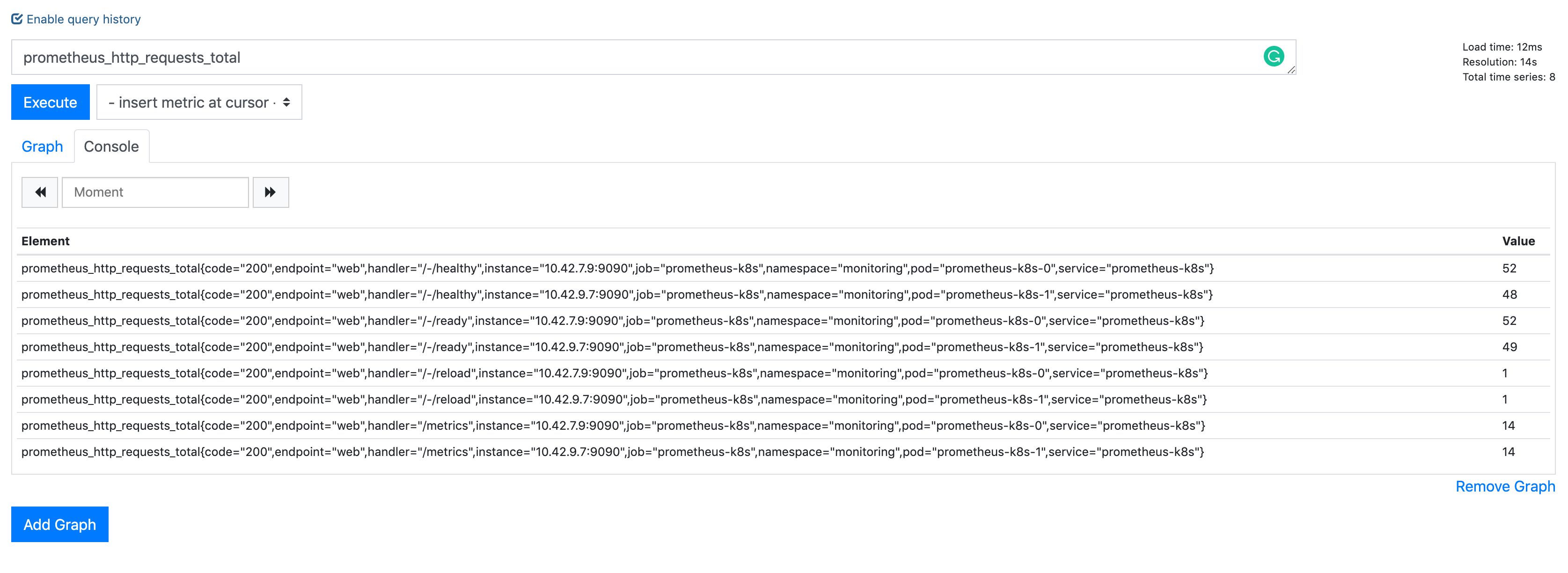
Range Vector
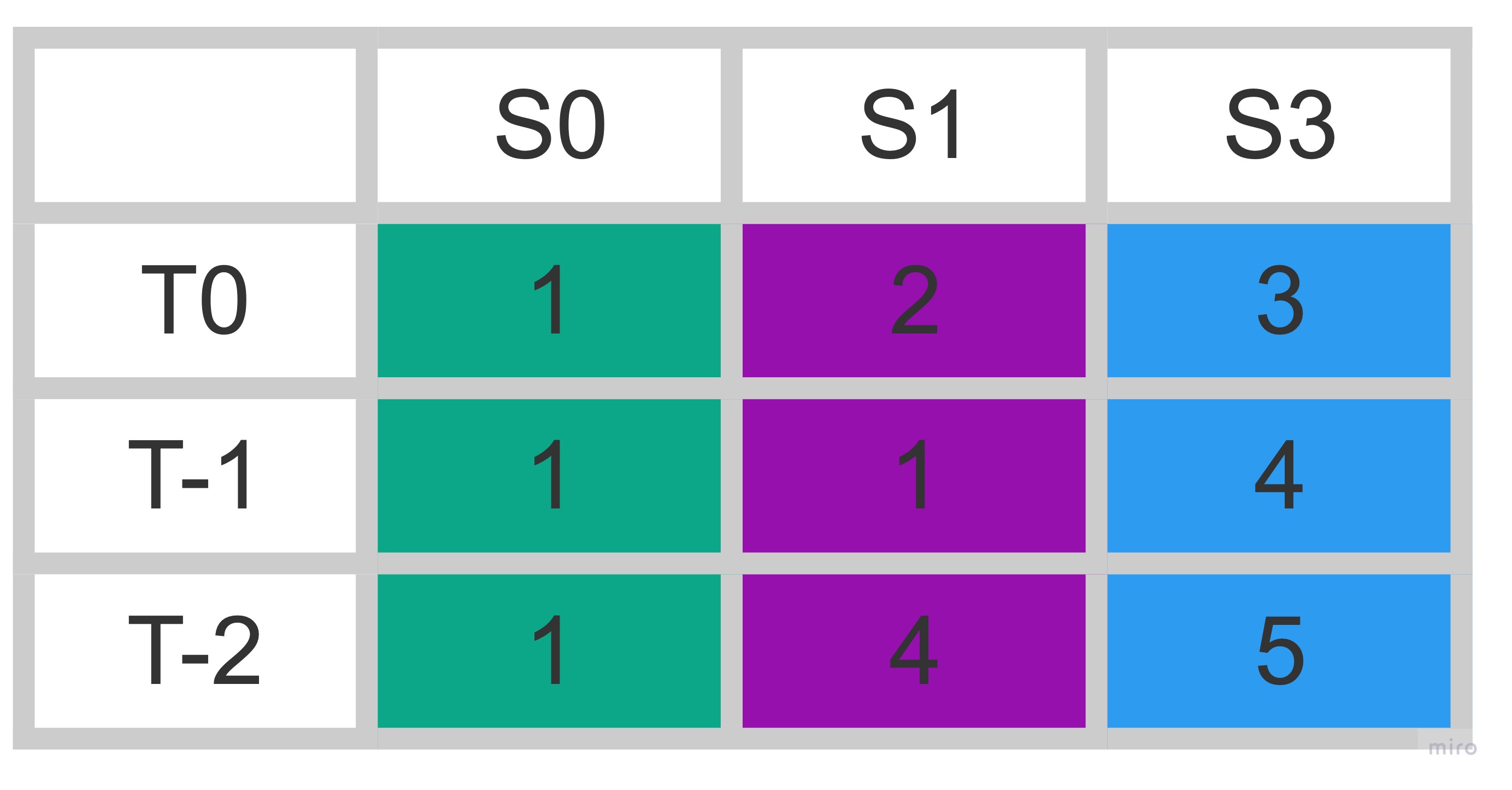
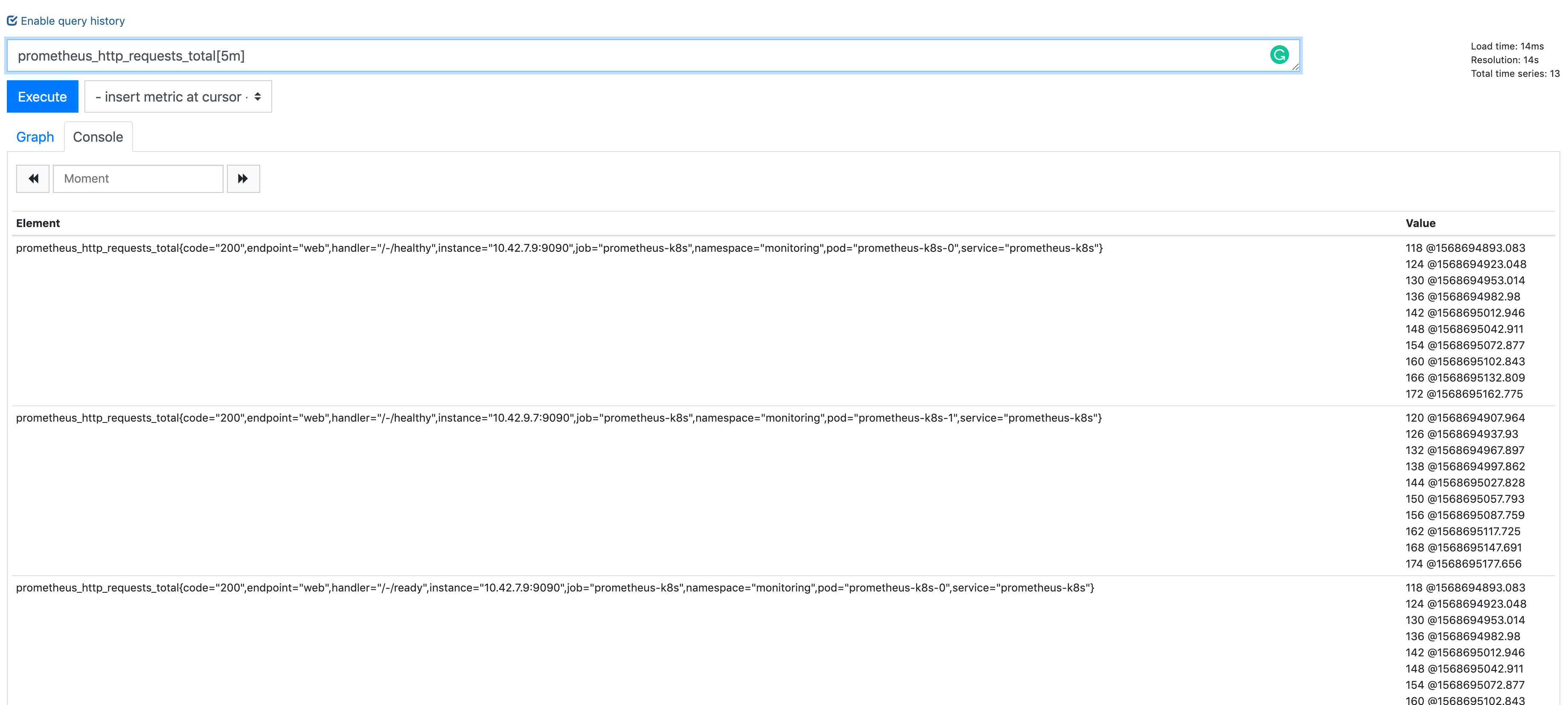
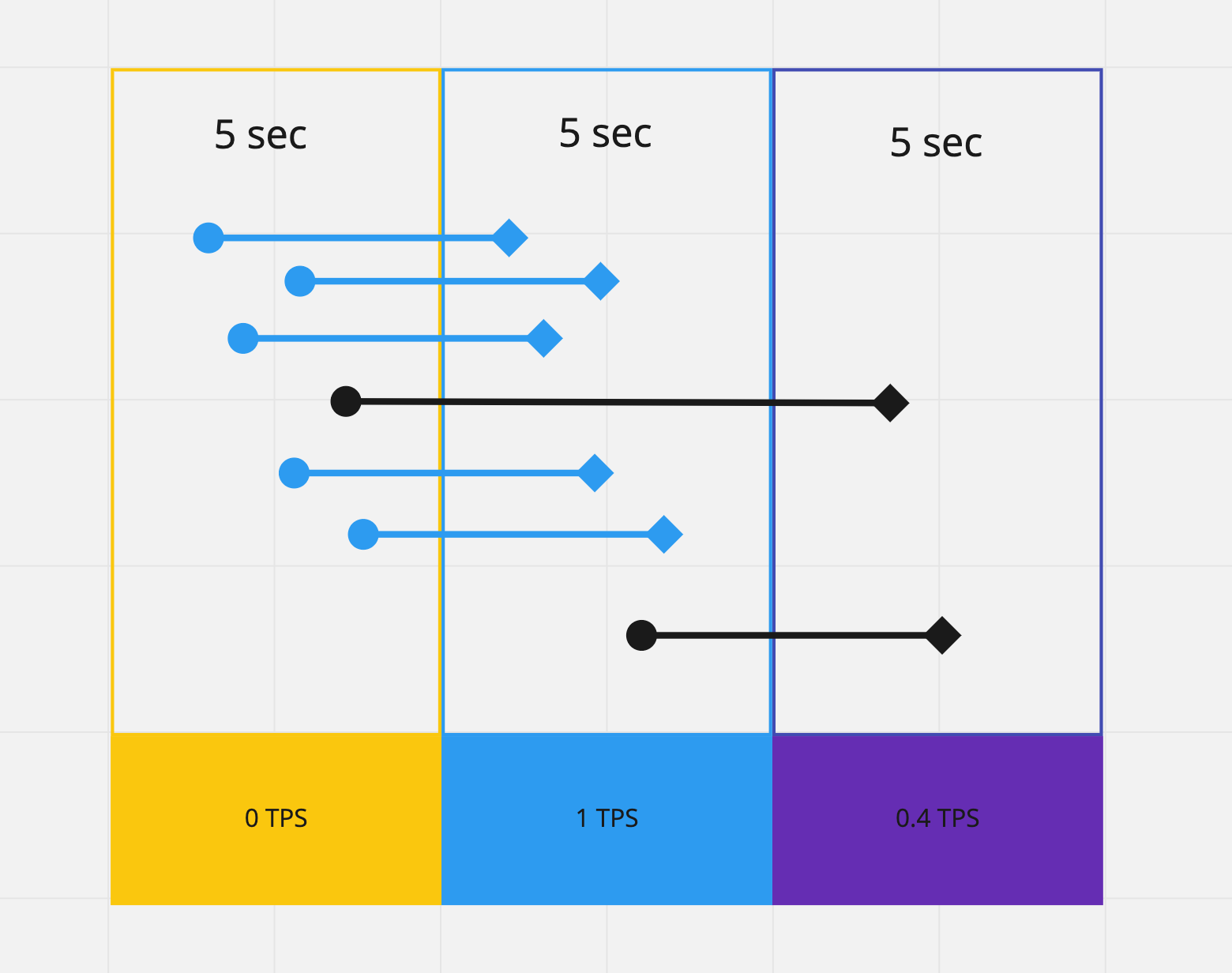

rate(node_network_receive_bytes_total[5m])Operators & Functions
- Operators:
- Aggregation operators
- Binary operators
- Vector Matching
- Functions:
rate(v range-vector)increase( v range-vector)avg_over_time(v range-vector)sum_over_time(v range-vector)absent(v instant-vector)- ...
Aggregation operators
Input:
Instant Vector-> Ouput:Instant Vector<aggr-op>([parameter,] <vector expression>) [without|by (<label list>)]- sum
sum(rate(http_requests_total[5m])) by (job)
- min, max
max by(instance)(node_filesystem_size_bytes)
- count, count_values
count_values without(instance)("version", software_version)
- topk, bottomk
topk(3, sum(rate(instance_cpu_time_ns[5m])) by (app, proc))
- sum
Operators can either be used to aggregate over all label dimensions or preserve distinct dimensions by including a
withoutorbyclause.withoutclause removes listed labels from resulting vectorbyclause drops labels not listed from the resulting vector
Binary operators
- Arithmetic:
+,-,*,/,%,^- scalar/scalar
- vector/scalar
- vector/vector
(instance_memory_limit_bytes - instance_memory_usage_bytes) / 1024 / 1024
- Comparision:
==,!=,>,<,>=,<=- scalar/scalar, vector/scalar, and vector/vector
- Logical/set:
and: intersection between vector1 and vector2or: union of vector1 and vector2unless: elements of vector1 ofr which no matches in vector2
Vector matching
- Operations between vectors attempt to find a matching element in the right-hand side vector for each entry in the left-hand side.
- Label Matching
ignoringkeyword<vector expr> <bin-op> ignoring(<label list>) <vector expr>
onkeyword<vector expr> <bin-op> on(<label list>) <vector expr>
kube_pod_container_resource_requests_memory_bytes{container="doc"} / on (container) container_memory_usage_bytes{namespace="apimanager"}- One-to-one finds unique pair of entries with all labels matching
- One-to-Many / Many-to-one
group_left,group_rightdetermines cardinality- only used for comparison and arithmetic operations
This is really complex, but in the majority of cases this isn’t needed.
Vector matching
method_code:http_errors:rate5m{method="get", code="500"} 24method_code:http_errors:rate5m{method="get", code="404"} 30method_code:http_errors:rate5m{method="put", code="501"} 3method_code:http_errors:rate5m{method="post", code="500"} 6method_code:http_errors:rate5m{method="post", code="404"} 21method:http_requests:rate5m{method="get"} 600method:http_requests:rate5m{method="del"} 34method:http_requests:rate5m{method="post"} 120method_code:http_errors:rate5m{code="500"} / ignoring(code) method:http_requests:rate5m{method="get"} 0.04 // 24 / 600{method="post"} 0.05 // 6 / 120Vector matching
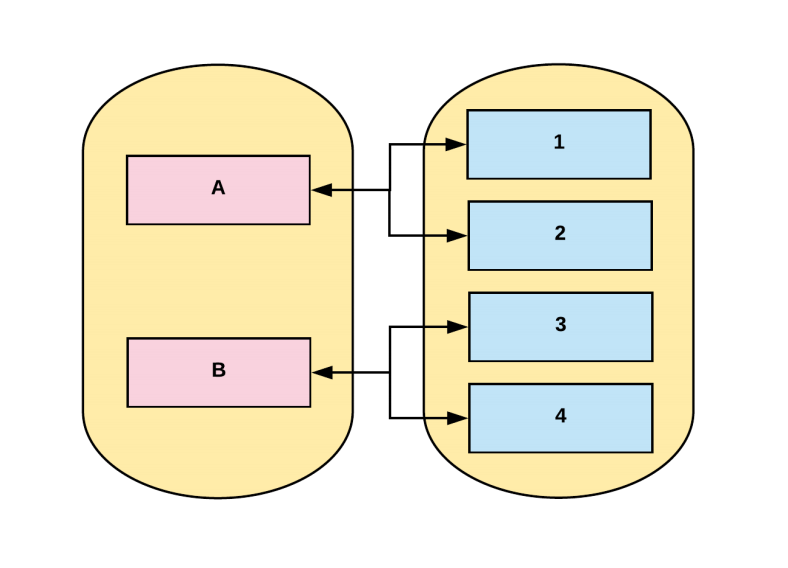
One-to-many,Many-to-one
Element on one side matches with many on the other
group_right when right side has higher cardinality
Many-to-one and one-to-many matching are advanced use cases that should be carefully considered.
Vector matching
method_code:http_errors:rate5m / ignoring(code) group_left method:http_requests:rate5m{method="get", code="500"} 0.04 // 24 / 600{method="get", code="404"} 0.05 // 30 / 600{method="post", code="500"} 0.05 // 6 / 120{method="post", code="404"} 0.175 // 21 / 120method_code:http_errors:rate5m{method="get", code="500"} 24method_code:http_errors:rate5m{method="get", code="404"} 30method_code:http_errors:rate5m{method="put", code="501"} 3method_code:http_errors:rate5m{method="post", code="500"} 6method_code:http_errors:rate5m{method="post", code="404"} 21method:http_requests:rate5m{method="get"} 600method:http_requests:rate5m{method="del"} 34method:http_requests:rate5m{method="post"} 120Vector matching
max by (namespace, pod, node, pod_ip) (kube_pod_info) * on (namespace, pod) group_left (phase) (kube_pod_status_phase{namespace="default"} == 1){namespace="...",pod="...",node="...",pod_ip="1.2.3.4",phase="..."} 1Recording rules
groups: - name: example rules: - record: pod:info expr: | max by (namespace, pod, node, pod_ip) (kube_pod_info) * on (namespace, pod) group_left (phase) (kube_pod_status_phase{namespace="default"} == 1) - record: pod:pending expr: pod:info{phase="Pending"} - record: job:http_inprogress_requests:sum expr: sum(http_inprogress_requests) by (job)Recording rules allow you to precompute frequently needed or computationally expensive expressions and save their result as a new set of time series. https://prometheus.io/docs/prometheus/latest/configuration/recording_rules/#recording-rules
Recording rules should be of the general form level:metric:operations.
Functions
label_join()
label_join(v instant-vector, dst_label string, separator string, src_label_1 string, src_label_2 string, ...)
label_join(up{job="api-server",src1="a",src2="b",src3="c"}, "foo", ",", "src1", "src2", "src3")
label_replace()
label_replace(v instant-vector, dst_label string, replacement string, src_label string, regex string
label_replace(up{job="api-server",service="a:c"}, "foo", "$1", "service", "(.*):.*")
increase(v range-vector)
increase(http_requests_total[1h])
Metric types
- Counter
- Gauge
- Histogram
- Summary
Gauge
A gauge is a metric that represents a single numerical value that can arbitrarily go up and down.
- heap memory used
- cpu usage
- items in queue
sum without(instance) (my_gauge)avg without(instance) (my_gauge)min without(instance) (my_gauge)max without(instance) (my_gauge)Counter
A counter is a metric that starts at 0 and is incremented.
rate(),increase(): This functions return gauges from counters_totalsuffix is describing counter metric type
sum without(instance) (rate(my_counter_total[5m]))Histogram
Samples observations(e.g. request durations or response sizes) and counts them in configurable buckets
- Bucket: Buckets are counter of observations.
<basename>_bucket {le = “<bound_value>”}
- Sum of the observation: the total sum of all observed values
<basename>_sum
- Count of the observation: count of events that have been observed
<basename>_count
histogram_quantile(0.9, sum without (instance)(rate(my_histogram_latency_seconds_bucket[5m])))request_latency_seconds_bucket{le="0.075"} 10.0request_latency_seconds_bucket{le="1.0"} 10.0request_latency_seconds_bucket{le="+Inf"} 11.0request_latency_seconds_count 11.0request_latency_seconds_sum 3.3Summary
Similar to a histogram, a summary samples observations (usually things like request durations and response sizes).
average latency:
sum without (instance)(rate(my_summary_latency_seconds_sum[5m]))/ sum without (instance)(rate(my_summary_latency_seconds_count[5m]))go_gc_duration_seconds{quantile="0"} 0.000236554go_gc_duration_seconds{quantile="0.25"} 0.000474629go_gc_duration_seconds{quantile="0.5"} 0.0005691670000000001go_gc_duration_seconds{quantile="0.75"} 0.000677597go_gc_duration_seconds{quantile="1"} 0.002479919go_gc_duration_seconds_sum 12.532527861go_gc_duration_seconds_count 24279Metric methods
- Four Golden Signals
- USE
- RED
Four Golden Signals
https://landing.google.com/sre/sre-book/chapters/monitoring-distributed-systems/
- Latency: The time it takes to service a request.
- Errors: The rate of requests that fail, either explicitly, implicitly, or by policy
- Traffic: A measure of how much demand is being placed on your system
- Saturation: How "full" your service is.
USE method
http://www.brendangregg.com/usemethod.html
- Resource: all physical server functional components (CPUs, disks, busses, …)
- Utilization: the average time that the resource was busy servicing work
- Saturation: the degree to which the resource has extra work which it can’t service, often queued
- Errors: the count of error events
USE Method: Linux Performance Checklist: http://www.brendangregg.com/USEmethod/use-linux.html
RED method
- Rate: The number of requests per second.
- Errors: The number of those requests that are failing.
- Duration: The amount of time those requests take.
"The USE method is for resources and the RED method is for my services” — Tom Wilkie
RED Method
from: https://www.weave.works/blog/the-red-method-key-metrics-for-microservices-architecture/
Another nice aspect of the REDMethod is that it helps you think how to build your dashboards.
You should bring these three metrics front-and-center for each service and error rate should be expressed as a propotion of request rate.
At Weaveworks,we settled on a pretty standard format for our dashboards
- two columnes, one row per service, request & error rate on the left, latency on the right
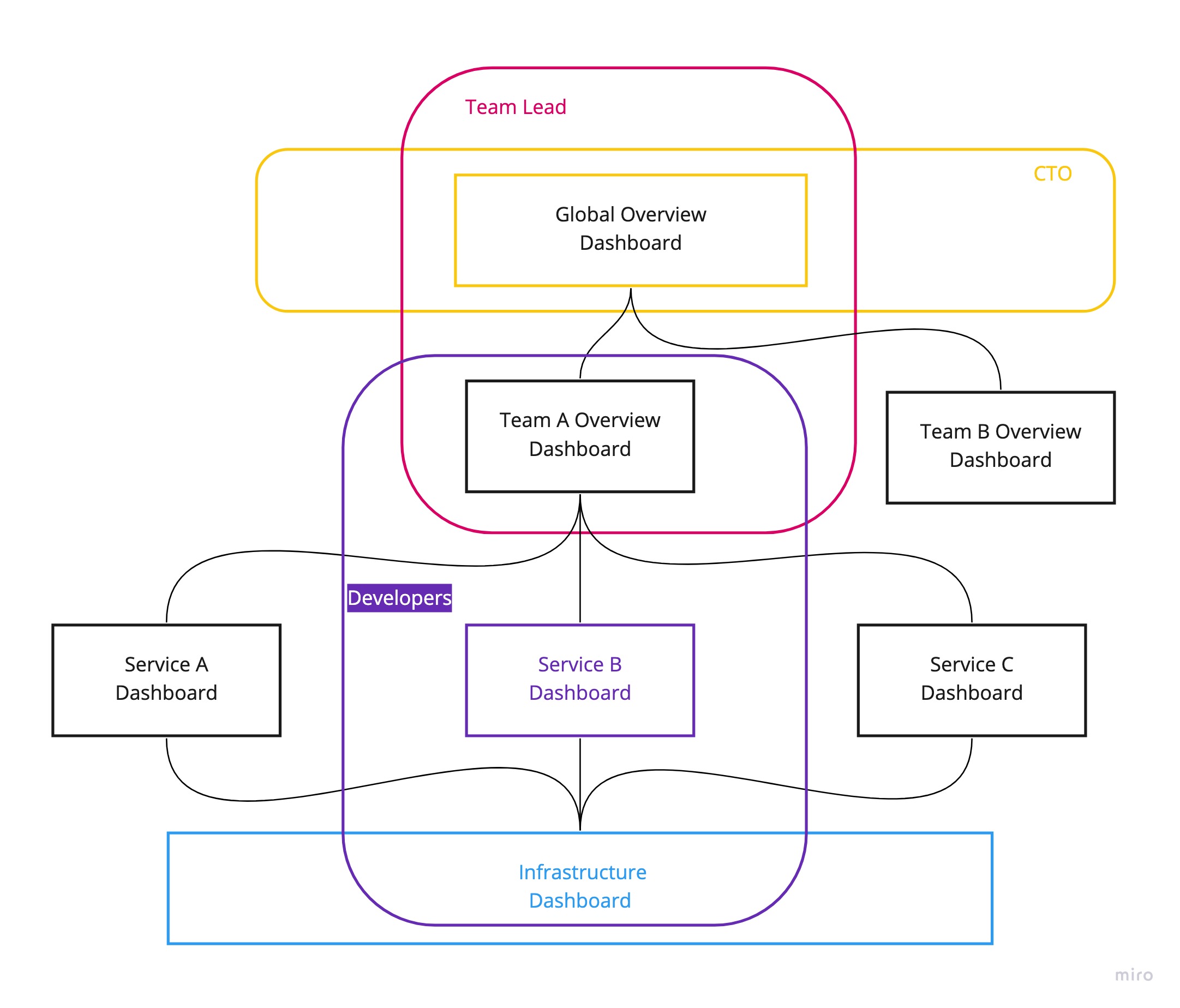
Node Metrics and the USE Method
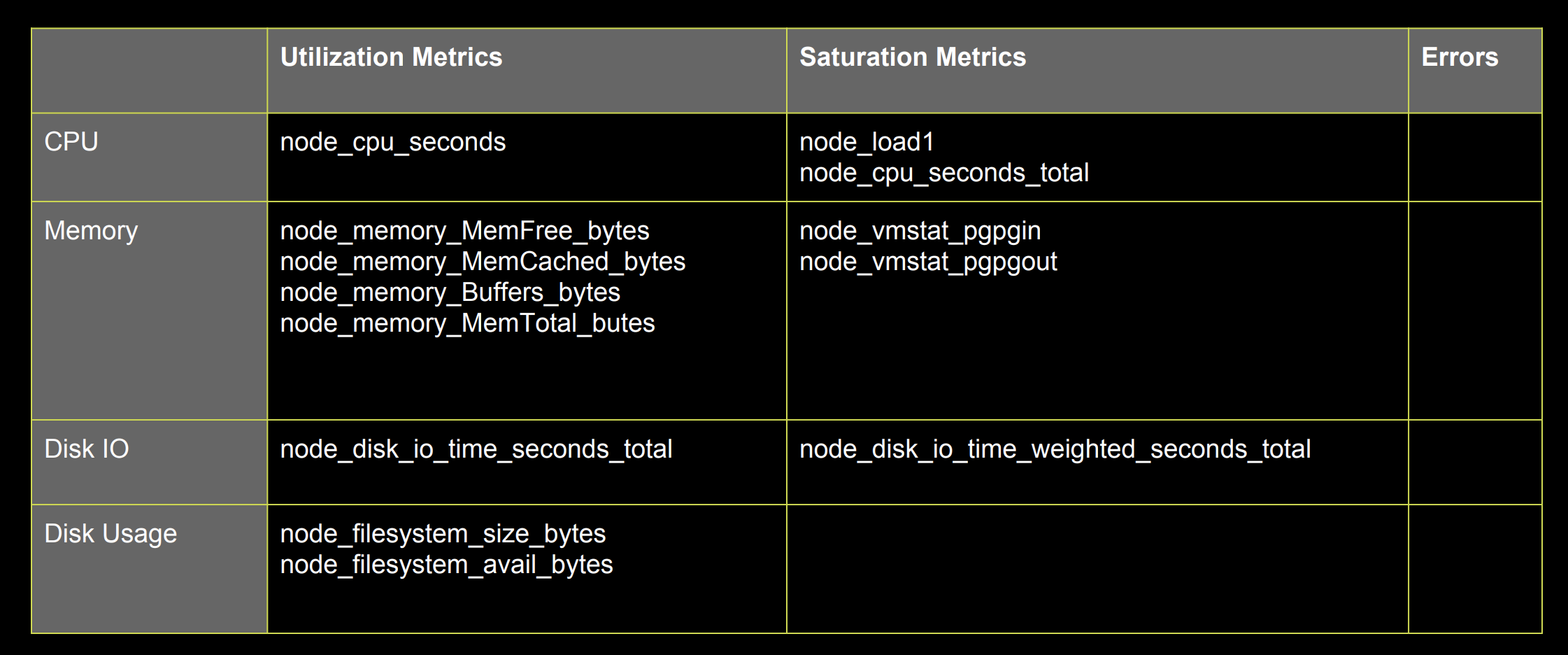
sum(rate(node_cpu_seconds_total{mode!="idle",mode!="iowait" }[5m])) BY (instance)count(node_cpu{mode="system"}) by (node)sum(node_load1) by (node) / count(node_cpu{mode="system"}) by (node) * 100Container Metrics from cAdvisor
Containers are a Resource - USE

sum(rate(container_cpu_usage_seconds_total[5m])) by (contaner_name)sum(container_memory_working_set_bytes{name!~"POD"}) by (name)sum(rate(container_network_receive_bytes_total[5m])) by (name)sum(rate(container_network_transmit_bytes_total[5m])) by (name)The K8s API Server is a Service - RED

sum(rate(apiserver_request_count[5m])) by (resource, subresource, verb)histogram_quantile(0.9, sum(rate(apiserver_request_latencies_bucket[5m])) by (le, resource, subresource, verb) ) / 1e+06kube-state-metrics
https://github.com/kubernetes/kube-state-metrics
kube-state-metrics is a simple service that listens to the Kubernetes API server and generates metrics about the state of the objects.
https://github.com/kubernetes/kube-state-metrics/tree/master/docs
count(kube_pod_status_phase{phase="Running"})count(kube_pod_status_phase{phase="Failed"})kube_pod_labels{ label_name="frontdoor", label_version="1.0.1", label_role="blue", label_service="aservice", namespace="default", pod="frontdoor-xxxxxxxxx-xxxxxx",} = 1kube_pod_labels
http_requests_total{code="200",endpoint="http-metrics",handler="prometheus",instance="1.1.1.1:10252",job="kube-controller-manager",method="get",namespace="kube-system",pod="kube-controller-manager.internal",service="kube-controller-manager"}sum( rate(http_request_count{code=~"^(?:5..)$"}[5m])) by (pod) * on (pod) group_left(label_version) kube_pod_labelsCRD : https://github.com/kubernetes/kube-state-metrics/issues/303
